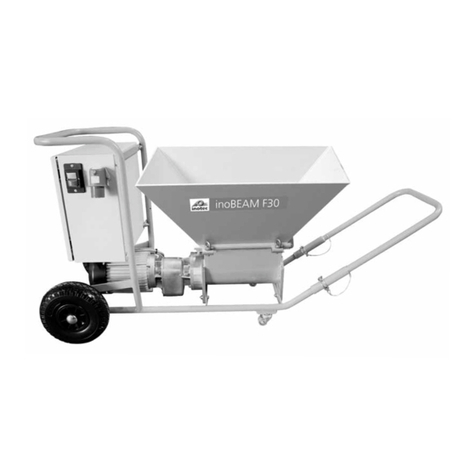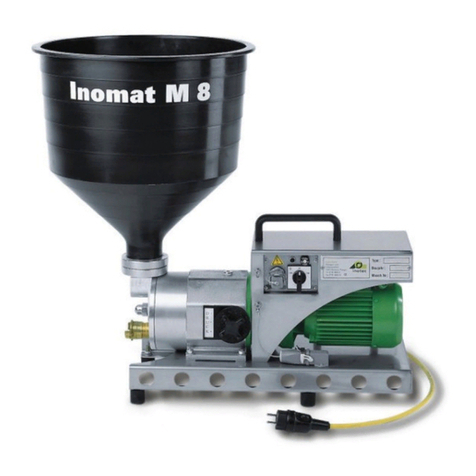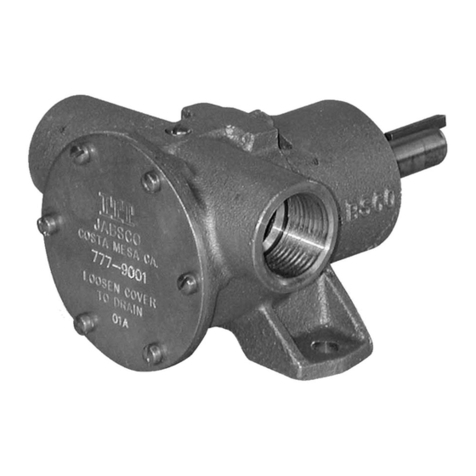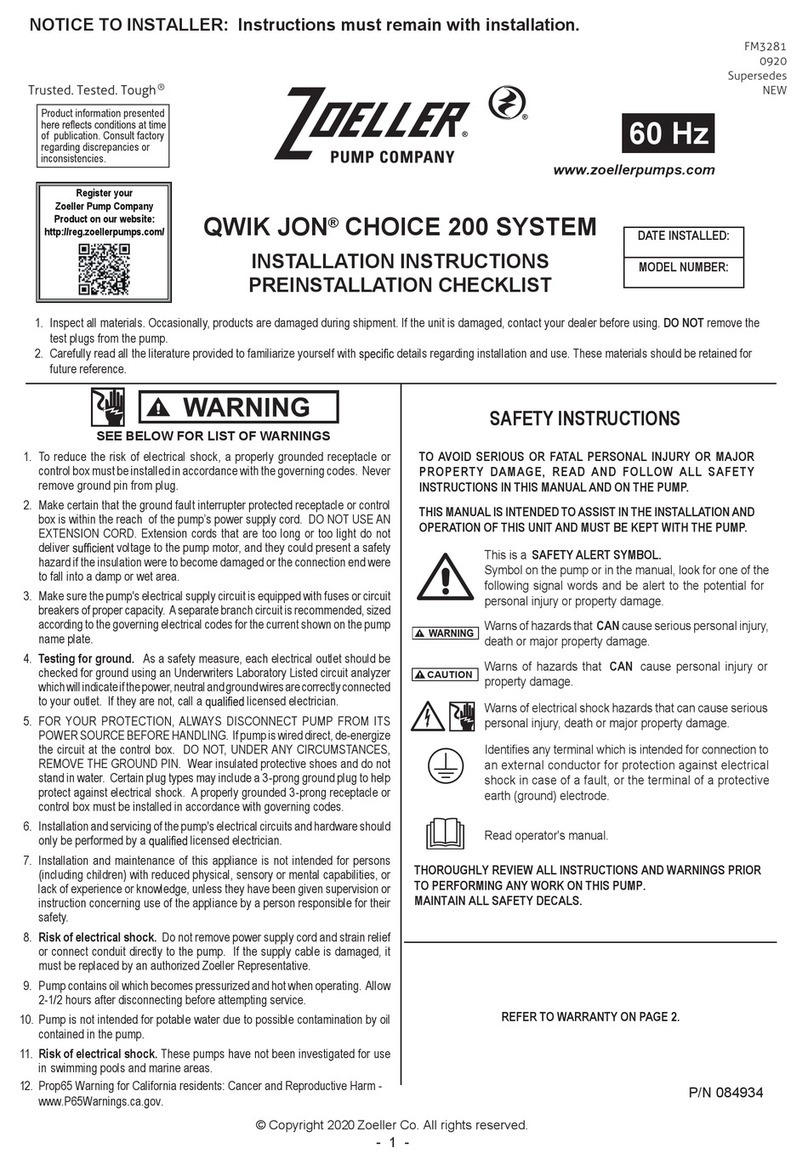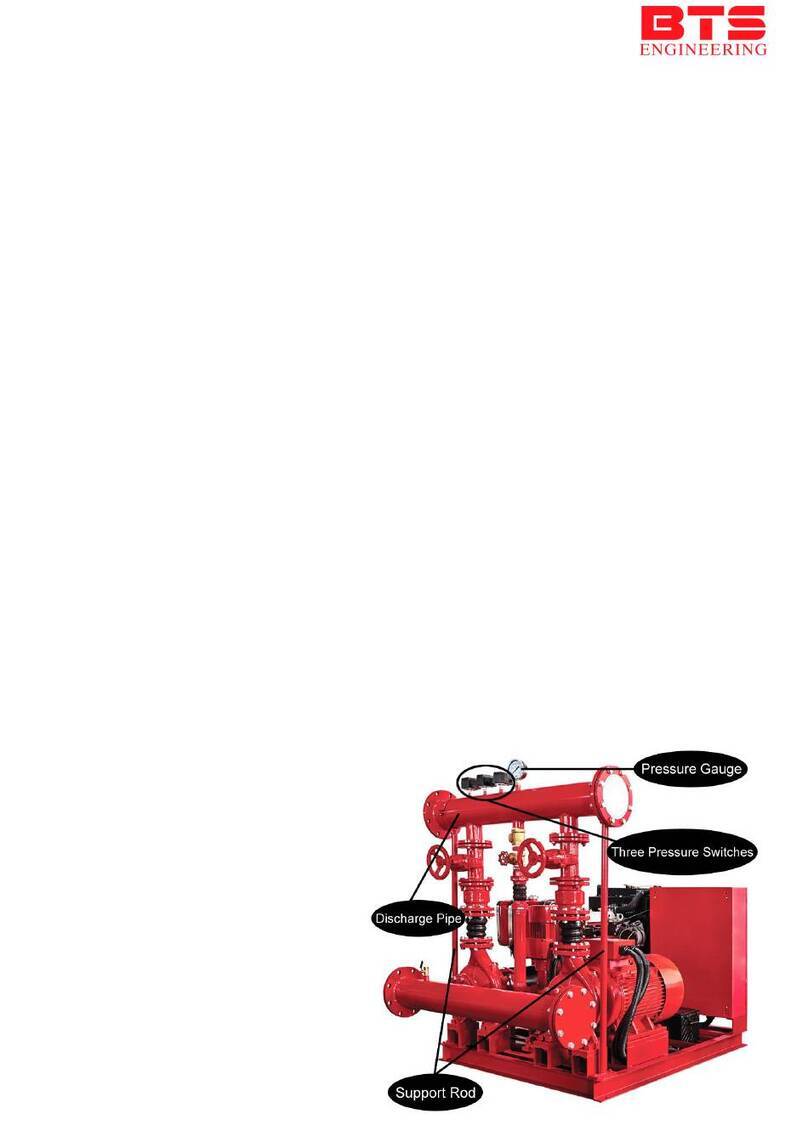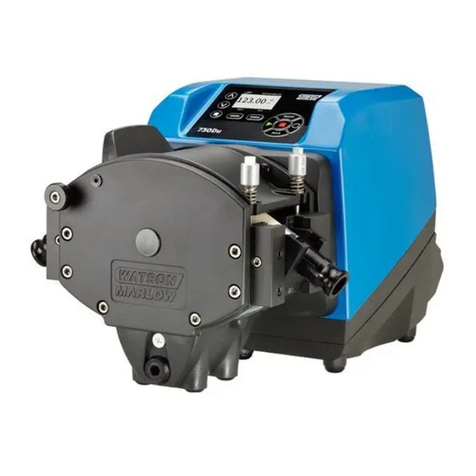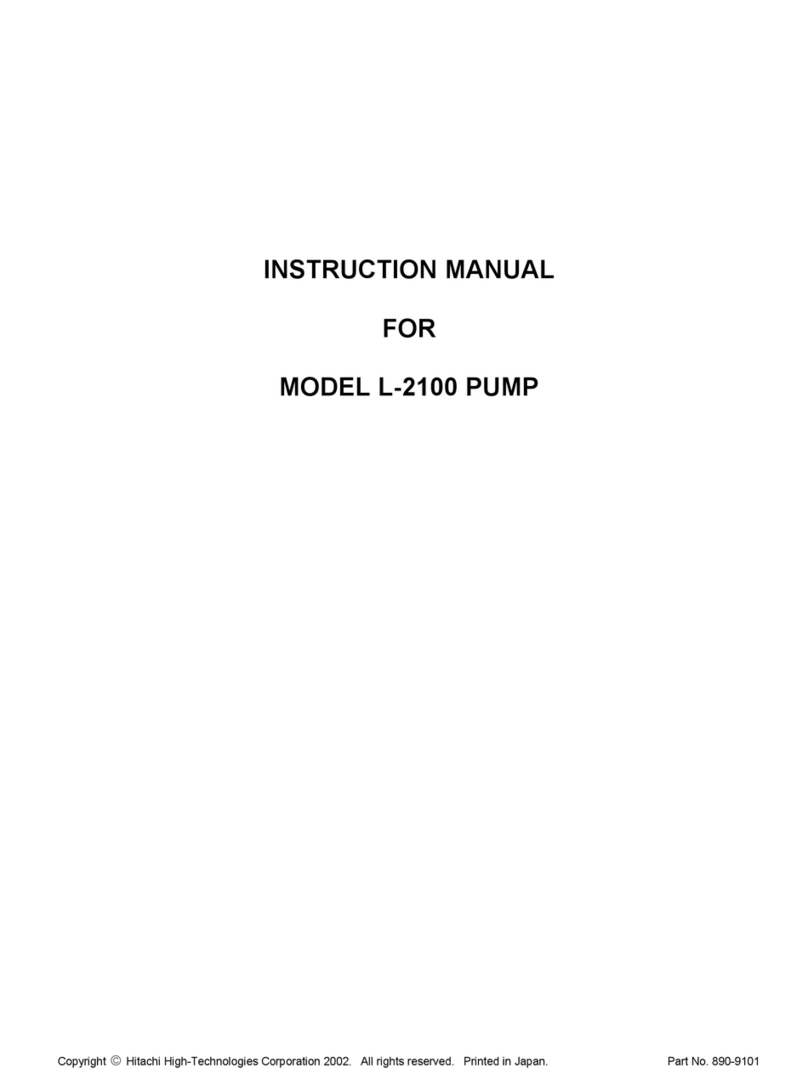InoTec inoCOMB Maxi Power Installation instructions

EN
Original Operating Manual
inoCOMB Maxi Power mixing pump
Read this entire original operating manual before starting work.

EN
Page 2
Thank you for trusting INOTEC. By purchasing you have opted for a quality product.
If you have any suggestions or any issues, we would be delighted to hear your suggestions for improvement
and your feedback. Speak to the sales representative assigned to you or, in urgent cases, contact us directly.
We work constantly to further develop our products and reserve the right to make changes for technical reasons
relating to building legislation.
Yours faithfully
INOTEC GmbH
Legal notice
Address: INOTEC GmbH
Daimlerstraße 9-11
79761 Waldshut-Tiengen
Germany
Tel.: +49 (0)7741 6805 666
Fax: +49 (0)7741 6805 665
Web: www.inotec-gmbh.com
Last updated: August 2021
Document number: 10044216-OBA-EN

Page 3
Inhalt
1 General information.................................................................................................................................. 5
1.1 Information about this manual ........................................................................................................................5
1.2 Symbol explanation ..........................................................................................................................................5
1.3 Information about this manual ........................................................................................................................5
1.3.1 Purpose of this operating manual...................................................................................................................................5
1.3.2 Disclaimer ......................................................................................................................................................................5
1.3.3 Warranty........................................................................................................................................................................5
1.3.3.1 Exercising claims .........................................................................................................................................................5
1.3.3.2 Warranty claims ..........................................................................................................................................................6
1.3.4 Carrying out repairs .......................................................................................................................................................6
2 Safety.......................................................................................................................................................... 6
2.1 Intended use ......................................................................................................................................................6
2.2 General risk sources...........................................................................................................................................7
2.2.1 Notices in the operating manual.....................................................................................................................................7
2.2.2 Performing checks before starting work .........................................................................................................................7
2.2.3 Conversions and changes...............................................................................................................................................8
2.2.4 Cleaning and maintaining the machine ..........................................................................................................................8
2.2.5 Changing the location of the machine ...........................................................................................................................8
2.3 Notices on the machine ....................................................................................................................................8
2.4 Personnel qualification......................................................................................................................................9
2.5 Responsibility of the operator..........................................................................................................................9
2.6 Personal protective equipment (PPE) ...............................................................................................................9
3 Technical data............................................................................................................................................. 9
3.1 Rating plate .......................................................................................................................................................9
3.2 Electric control system, pump output, particle size, weight, dimensions .....................................................9
3.3 Water measuring system.................................................................................................................................10
3.4 Material hopper ...............................................................................................................................................10
3.5 Pump motor .....................................................................................................................................................10
3.6 Star feeder motor ............................................................................................................................................10
3.7 Rotor/stator......................................................................................................................................................10
3.8 Noise emissions................................................................................................................................................10
3.9 Operating conditions.......................................................................................................................................10
4 Assembly and function ........................................................................................................................... 10
4.1 Scope of delivery of inoCOMB Maxi Power set ............................................................................................10
4.2 Functionality ....................................................................................................................................................10
4.3 Components .....................................................................................................................................................11
4.3.1 Description of the components ....................................................................................................................................11
4.3.1.1 Frame with wheels, material hopper, star feeder and star feeder motor.....................................................................12
4.3.1.2 Mixing pump unit (mixing zone with mixing coil, rotor / stator and mortar pressure gauge).......................................12
4.3.1.3 Pump motor .............................................................................................................................................................12
4.3.1.4 Switching cabinet .....................................................................................................................................................12
4.3.1.5 Water fitting .............................................................................................................................................................12
4.3.1.6 Air fitting ..................................................................................................................................................................12
4.3.1.7 Compressor ..............................................................................................................................................................12
4.4 Displays and controls ......................................................................................................................................13
4.4.1 Switching cabinet ........................................................................................................................................................13
4.4.1.1 Main switch ..............................................................................................................................................................13
4.4.1.2 Star feeder selector switch ........................................................................................................................................13
4.4.1.3 Start / stop button ....................................................................................................................................................13
4.4.1.4 Phase-change switch with locking button..................................................................................................................13
4.4.1.5 “Water supply” push button.....................................................................................................................................13
4.4.2 Mixing pump unit (motor, mixing coil, rotor/stator and mortar pressure gauge) ............................................................14
4.4.3 Water fitting ................................................................................................................................................................14
4.4.4 Installing the water fitting ............................................................................................................................................15
4.4.5 Air fitting .....................................................................................................................................................................15
4.4.6 Compressor .................................................................................................................................................................15
4.5 Connections......................................................................................................................................................16
4.5.1 Power connections (230 / 400 V) ................................................................................................................................16
4.5.2 Water fitting connections.............................................................................................................................................16
4.6 Operating modes .............................................................................................................................................16
4.7 Accessories .......................................................................................................................................................17

EN
Page 4
4.8 Spare parts and diagrams ...............................................................................................................................23
4.8.1 Overview of frame with material hopper and star feeder..............................................................................................23
4.8.2 Mixing zone spare parts list..........................................................................................................................................25
4.8.3 Water fitting ................................................................................................................................................................26
5 Transport and storage ............................................................................................................................. 30
5.1 Safety notices for transport............................................................................................................................30
5.2 Transport inspection........................................................................................................................................30
5.3 Damage report.................................................................................................................................................30
5.4 Complaints .......................................................................................................................................................30
5.5 Packaging .........................................................................................................................................................30
5.6 Transport of the used machine in vehicle......................................................................................................31
5.7 Storage .............................................................................................................................................................31
6 Installation ............................................................................................................................................... 31
6.1 Delivery condition of the machine .................................................................................................................32
6.2 Connecting the compressor ............................................................................................................................32
6.3 Mounting / dismounting the mixing zone ....................................................................................................32
6.4 Installing the mixing coil.................................................................................................................................33
6.5 Connecting the electrical control system.......................................................................................................33
6.6 Mounting the pump unit (rotor / stator / pressure gauge)..........................................................................33
6.7 Installing the star feeder.................................................................................................................................33
6.8 Installing the water measuring system..........................................................................................................34
6.9 Checking the direction of rotation of the machine.......................................................................................35
6.10 Setting the water quantity ...........................................................................................................................36
6.11 Regulating the water pressure .....................................................................................................................36
6.12 Material preparation .....................................................................................................................................36
6.12.1 Adjusting the material consistency .............................................................................................................................37
6.13 Preparing the machine ..................................................................................................................................37
6.14 Starting the machine .....................................................................................................................................37
7 Commissioning ....................................................................................................................................... 38
7.1 Adding material to the material hopper........................................................................................................38
7.2 Opening and emptying bags of material.......................................................................................................38
7.3 Changing material ...........................................................................................................................................38
7.4 Change of location on the construction site .................................................................................................38
8 Operation, use.......................................................................................................................................... 39
8.1 Checking operating performance...................................................................................................................39
8.2 Checking the consistency of the material......................................................................................................39
8.3 Correcting flow fluctuations...........................................................................................................................39
8.4 Work break/end of work.................................................................................................................................39
9 Areas of application ................................................................................................................................ 39
10 Cleaning & decommissioning ............................................................................................................... 40
10.1 Cleaning process ............................................................................................................................................40
10.2 After cleaning ................................................................................................................................................41
11 Maintenance........................................................................................................................................... 42
11.1 Maintenance plan ..........................................................................................................................................42
11.2 Dirt trap sieve in the water inlet ..................................................................................................................42
11.3 Dirt trap sieve in the pressure reducing valve.............................................................................................42
11.4 Set values .......................................................................................................................................................42
11.5 Pump and star feeder motor.........................................................................................................................42
12 Faults, causes and solutions ................................................................................................................. 43
13 Dismantling and disposal ..................................................................................................................... 46
13.1 Safety..............................................................................................................................................................46
13.2 Dismantling ....................................................................................................................................................46
13.3 Disposal ..........................................................................................................................................................46
14 Systems................................................................................................................................................... 47
14.1 EC declaration of conformity ........................................................................................................................47
14.2 General Terms of Business of the company INOTEC GmbH........................................................................48
14.3 Circuit diagram for inoCOMB Maxi Power...................................................................................................49
15 Order form.............................................................................................................................................. 50
16 Index ....................................................................................................................................................... 51
17 Locations ................................................................................................................................................ 52

Page 5
EN
Chapter 1 General information
1 General information
1.1 Information about this manual
• This manual helps to ensure safe and efficient use of
the machine.
• Operating personnel must have carefully read through
and understood this manual before starting any work.
• Compliance with all the specified safety instructions is
a basic prerequisite for working safely.
• This manual is a component of the machine and must
be stored within direct proximity of the machine, acces-
sible to operating personnel at all times.
• In addition to the notices in these instructions, the local
accident prevention guidelines and national occupa-
tional health regulations also apply.
1.2 Symbol explanation
Hazard notices feature symbols to make them easier to
identify. These indicate the severity of the hazard.
• You must observe this information.
!
DANGER DANGER indicates an immediate hazard.
Death or serious injuries may result from non-compliance.
!
WARNING WARNING indicates a potentially dangerous
situation. Death or serious injuries may result from a failure
to avoid these situations.
!
CAUTION CAUTION indicates a potentially dangerous
situation. Minor or slight injuries may result from failure to
avoid these situations or damage to the machine or some-
thing in its vicinity.
NOTE
NOTICE draws your attention to useful tips for
effectively handling the machine.
1.3 Information about this manual
1.3.1 Purpose of this operating manual
The operating manual is used to provide information to the
operating manager, assembly fitters and machine operators
on the construction site. It contains important instructions
for safe use, optimum results and a long service life.
!
DANGER Risk of incorrect operation
Failure to observe the operating manual could put the
operator’s life and health at risk and damage the ma-
chine.
• Read this operating manual carefully before passing it
on to your assembly fitters or operators.
• Please ensure that assembly fitters and operators read
this operating manual carefully before they start install-
ing and commissioning the machine.
• Always keep the operating manual to hand and in a leg-
ible condition.
1.3.2 Disclaimer
All technical information, data and instructions for use con-
tained in this operating manual reflect the state of the art at
the time of printing and are based on our experience thus
far and the best of our knowledge.
The manufacturer cannot be held liable for any damages as
a result of:
• Failure to comply with this manual
• Improper use
• Assignment of non-trained personnel
• Unauthorised alterations
• Technical changes
• Use of non-approved spare parts
1.3.3 Warranty
Statutory warranty periods of 12 months from the date of
purchase/the date of invoice of the industrial end customer
apply to our machinery.
1.3.3.1 Exercising claims
In the event of a warranty claim, send the entire machine,
along with the invoice, to our headquarters in Wald-
shut-Tiengen.
Contact our free INOTEC service hotline beforehand on
+49 7741 6805 777.

Page 6
EN
Chapter 2 Safety
1.3.3.2 Warranty claims
Claims apply only where material or manufacturing faults
exist and where machinery has been used properly. Wear
parts are not covered by the warranty. All claims shall be-
come void if third-party parts are installed, where the ma-
chinery has been improperly used or stored and in the event
of obvious non-compliance with the operating manual. In
this connection, we refer you to our General Terms of Busi-
ness.
1.3.4 Carrying out repairs
Repairs may only be carried out by employees at our
INOTEC service centres.
2 Safety
2.1 Intended use
You may only operate this machine if the following
conditions are met:
• The inoCOMB Maxi Power is suitable for mixing,
conveying and spraying all factory pre-mixed and
machine-compatible mortars. The machine can be fed
with powdery material from bags, one-way containers
(with the dry conveying unit
inoFLEX Mono), big bags (with the Big-Bag-Box Mono)
or silos (with a conveyor system).
• The material is pumped in mortar hoses to the pro-
cessing location, where it is applied to or poured into
walls, ceilings or flooring by means of the appropriate
spray guns or glue guns.
• Only use the machine within its limits of application
and according to the technical data.
• Pay particular attention to the safety and warning
notices outlined in this original operating manual.
!
DANGER Failure to use the
inoCOMB Maxi Power properly could put the user’s
life and limb at risk and damage the inoCOMB Maxi
Power or other assets.
!
WARNING Danger due to misuse!
Misuse of the inoCOMB Maxi Power may lead to dan-
gerous situations.
• Never use the inoCOMB Maxi Power mixing pump to cre-
ate other products, such as food.
• Never operate the inoCOMB Maxi Power mixing pump
using values out of the ranges specified in the “Technical
Data”.

Page 7
EN
Chapter 2 Safety
2.2 General risk sources
!
DANGER Electrical voltage.
Danger of death due to electric shock.
• Work on the electronic control system may only be per-
formed by a qualified electrician.
• Connect the mixing pump only to regulation construc-
tion site power distribution points with FI circuit breakers
(30 mA).
• The connection must be fused with 25 A.
• The cross-section of the supply cable is at least 4.0 mm2
at 400 V 3 PH
• Connect the supply cable to the feed-in connector of the
switching cabinet.
• All operating equipment on the construction site must
generally be connected according to BGI/GUV-I 608.
!
DANGER Rotating mixing shafts.
Danger of death due to being pulled into the ma-
chine and crushed.
When the motor is running, the mixing shaft rotates
in the mixing zone!
• Do not reach into the rotating mixing shaft.
• Do not place any objects into the rotating mixing shaft.
1. Before working on the metering and mixing shaft, inter-
rupt the external power supply (main switch off).
2. Pull out the mains plug.
3. Secure the machine against unexpectedly being switched
back on.
4. Open the eccentric lock on the motor and move it away
to the side.
!
DANGER Pressurised conveyor hoses.
Risk of injury and risk of property damage due to es-
caping and/or flying material, and/or bursting con-
veyor hoses.
• Before disconnecting the conveyor hoses, make sure that
the hoses are depressurised. To do so, check the pressure
indicator on the mortar pressure gauge. The pressure in-
dicator must display 0 bar!
• Before opening the hose coupling, let the
inoCOMB Maxi Power run in reverse to reduce any pres-
sure! To do this, turn the phase-change switch (1) until
the red illuminated button on the machine’s switching
cabinet (2) lights up. Then press the red illuminated but-
ton. The pump then runs backwards.
12
• Use only conveyor hoses which are permissible with an
operating pressure of 40 bar and a burst pressure of 120
bar, and are in a technically perfect condition (e.g. are
without any cracks or other external damage!).
!
WARNING Water jet.
Risk of injury and risk of property damage due to es-
caping water.
1. Interrupt the external water supply by closing the water
valve.
2. In order to release the pressure (approx. 2 bar), open
the water drainage valve on the water measuring sys-
tem under the pressure reducer.
3. Only remove the hose from the external water supply
when the pressure gauge shows “0” bar.
4. Do not point the water jet at other people or yourself.
2.2.1 Notices in the operating manual
!
CAUTION Safety notices in the operating manual
alert the operating personnel to any immediate dan-
ger. Please observe all the technical and hazard notic-
es in this operating manual.
2.2.2 Performing checks before starting work
!
WARNING Defects or damage can put the safety of
operating personnel at risk and impair the functional-
ity of the machine.
• Before commencing work, check the machine for any
obvious external damage or defects.
• Do not commission the machine if you notice any dam-
age to or defects in the machine or to the conveyor hos-
es.
• Ensure that the damage and/or defects are rectified.

Page 8
EN
Chapter 2 Safety
2.3 Notices on the machine
!
DANGER Safety notices on the machine make oper-
ating staff aware of imminent danger.
The following warning notices are affixed to the inoCOMB
Maxi Power:
Instructions on the mixed zone:
• Pressurised parts! Depressurise the machine before any
cleaning or maintenance work (1).
Instructions on the switching cabinet:
• Switch off the main switch before opening the switching
cabinet housing (2).
• Read the operating instructions carefully before starting
work (3).
• Caution: live parts! Disconnect the mains plug before
carrying out any work (4).
• Incorrect direction of rotation (5)
• The device may only be operated via a connector protect-
ed with an RCD (FI) IDh ≤ 30 mA (sticker on the side of
the switching cabinet below the feeder).
Note on the four fold-out carrying handles:
• If a lifting device is used for transport, the attachment
points provided and marked for this purpose must be
used.
Instructions on the material hopper (6):
• Caution: rotating parts! Do not carry out any mainte-
nance or cleaning work with the machine running or
the protective cover removed.
Other notes:
• If there is a risk of frost, drain the water (see water fit-
ting).
Observe all the safety and hazard notices that are attached
to the machine. Always keep the safety and hazard notices
in a clearly legible condition.
1345
56
2
2.2.3 Conversions and changes
!
DANGER Conversions or changes can put the safe-
ty of operating staff at risk and impair the functional-
ity of the machine.
• Do not make any changes, additions or conver-
sions to the machine without first consulting
Inotec GmbH and obtaining its written approval. Other-
wise, the operating license will become void.
2.2.4 Cleaning and maintaining the machine
!
WARNING Cleaning and maintenance work can put
the safety of operating staff at risk and impair the
functionality of the machine.
1. Switch off the machine and pull out the mains plug.
2. Secure the machine against unexpectedly being
switched back on.
3. Before cleaning with the water jet, cover all the open-
ings that water must not penetrate into for safety and
functional reasons.
4. After cleaning, remove all the covers which were at-
tached to protect against the water.
2.2.5 Changing the location of the machine
The inoCOMB Maxi Power is equipped with four wheels.
Convenient handles are fitted at all four corners for moving
the whole machine.
!
CAUTION Changing location can put the safety of
operating staff at risk and impair the functionality of
the machine.
1. Switch off the machine and pull out the mains plug.
2. Move the machine to a new location on the building
site.
3. Always install the machine in such a way that it is level
and stable.
4. Secure the machine against undesirable movements.

Page 9
EN
Chapter 3 Technical data
2.4 Personnel qualification
Inotec offers training sessions on operating the inoCOMB
Maxi Power. Use INOTEC service for the initial commis-
sioning of the machine; this also serves as an opportunity
to provide operators with training on how to operate the
mixer.
!
DANGER If the inoCOMB Maxi Power is operated
by unqualified individuals, this could put the life and
health of the operating staff at risk and cause prop-
erty damage to the inoCOMB Maxi Power or other
assets.
2.5 Responsibility of the operator
• Only task trained or instructed staff with operating the
inoCOMB Maxi Power.
• Define employees’ responsibilities for operating, setting
up, maintaining and servicing the machine clearly.
• Only task untrained staff or individuals who have not re-
ceived any instruction with operating the machine when
there is a trained or instructed specialist available to su-
pervise them.
• Work on the electronic control system may only be per-
formed by a qualified electrician.
• When using a sprayer, never point it at people or at haz-
ardous objects.
2.6 Personal protective equipment (PPE)
!
CAUTION PPE – particularly gloves, safety boots,
a safety helmet and safety goggles and respira-
tory protection – must be used. Even though the
inoCOMB Maxi Power mixing pump does not cause
any increased noise pollution, we recommend the use
of hearing protection on the construction site.
3 Technical data
3.1 Rating plate
1
5
4
23
Item Component Value
1 Manufacturer, address and contact
details, CE marking
-
2 Name and type of machine -
3 Machine’s year of construction -
4 Machine number -
5Technical data
- Voltage
- Current
- Output
400 V
32 A
5.5 kW
You must always state the machine number if you would
like to order spare parts, have any queries or would like
to make a complaint. You will find this information on the
rating plate or on the delivery note.
3.2 Electric control system, pump output, particle size,
weight, dimensions
Mains voltage 400 V, 50 Hz
Mains supply line (CEE plug) 32 A (to be supplied by
customer)
Pump motor power 5.5 kW
Star feeder motor power 0.55 kW
Fuse min. 25 A
Delivery rate* approx. 8-50 l/min.
mineral
Delivery range* up to 50 m
Delivery height* up to 30 m
external (without compressor) approx. 250 kg
Dimensions:
Length 1,050 mm
Width 720 mm
Height 1,530 mm
* Material-dependent and depending on the consistency of the material –
observe the material manufacturer’s instructions.

Page 10
EN
Chapter 4 Assembly and function
3.3 Water measuring system
Pressure being too low min. 2.5 bar
Pressure reducer
ex-works setting
2.0 bar
Solenoid valve 42 V
Supply line ¾ inch water pipe
(to be supplied by cus-
tomer)
3.4 Material hopper
Fill quantity max. 145 l
3.5 Pump motor
Output/rotation speed 5.5 kW, 419 U/min-1
Installation position Motor vertical
Electrical data f = 50 Hz, I = 11.1 A,
U = 400 V, IP 55
Insulation class F, ED = S1
Colour Black
3.6 Star feeder motor
Output/rotation speed 0.55 kW, 29 rpm
Installation position Motor horizontal
Electrical data f = 50 Hz, I = 1.5 A,
U = 400 V, IP 55
Insulation class F, ED = S1
Colour Black
3.7 Rotor/stator
D6-3 Standard
D4 1/4 output
D4 1/2 output
D6-3 Helix
R7 - 1.5
D8-1.5
D8-2
Depending on the
material
3.8 Noise emissions
Sound power level LWA 80 dB (A)
3.9 Operating conditions
Temperature range 2 - 45 °C
Relative humidity, maximum 80 %
4 Assembly and function
4.1 Scope of delivery of inoCOMB Maxi Power set
(Item no. 10044216)
The scope of delivery is generated using the components
ordered and can be checked using the delivery note.
• Frame, reinforced version
• 4 running wheels
• Material hopper (galvanised)
• Geared motor (with reinforced axial bearing)
• Rotor/stator D 6-3
• Switching cabinet
• Mortar pressure gauge
• Compressor
• Mixing coil
• Water fitting
• Water pump
• Mortar hose Ø 25 mm, 10 m
• Air hose, Ø ½”, 15 m
• Tool set
• Straight finishing coat device incl. nozzle with a
diameter of 14 mm
• Assembly, spray lubricant
• Operating manual
4.2 Functionality
The mixing pump is filled with powdery material, for in-
stance, bagged goods. The mixing coil and pump unit (ro-
tor/stator) are directly driven by a gear motor. During oper-
ation, the powdered material is conveyed from the material
hopper over the star feeder into the mixing zone, − where it
is mixed with water with the mixing coil − to form a homo-
geneous, paste-like product. The pump unit (rotor/stator)
attached at the lower end of the mixing zone conveys the
mixture through flexible conveyor hoses to the spray gun
or glue gun. The machine is controlled either pneumatically
(via the air valve on the spraying device or electrically via a
remote control cable laid from the switching cabinet to the
spraying device. Here, the machine is controlled by an on/
off switch.
NOTE
If the machine control is to be changed
from electric to pneumatic, the dummy plug must be
plugged into the Harting plug of the switching cabi-
net.

Page 11
EN
Chapter 4 Assembly and function
NOTE
Note the optimum assembly sequence.
1. Assemble the pump unit (rotor/stator/pressure flange/
pressure gauge) with both tie rods at the lower end of
the green mixing zone. For easier installation, the com-
plete mixing zone incl. motor can be placed at an angle.
2. Open the eccentric lock on the motor and move it
away to the side. Push the mixing coil into the mixing
zone. Then move the motor back again and close the
eccentric lock. Ensure that the mixing coil is connected
to the motor and rotor of the pump unit via the motor
bracket.
3. Connect the input socket to the external (on-site) pow-
er supply (400 V / 32 Hz)
4.3 Components
7
3
5
6
2
4
1
4.3.1 Description of the components
Item Component
1 Frame with wheels, material hopper,
star feeder and star feeder motor
2 Pump unit (mixing zone with mixing coil,
rotor / stator with mortar pressure gauge)
3 Mixing pump motor
4 Switching cabinet
5 Air fitting (not visible)
6 Water fitting
7 Compressor

Page 12
EN
Chapter 4 Assembly and function
4.3.1.1 Frame with wheels, material hopper, star feed-
er and star feeder motor
The material hopper, switching cabinet, the mixing pump
unit with mixing zone and motor as well as the air and wa-
ter fittings are assembled on the frame. The star feeder is
fixed under the protective grid of the material hopper.
Material hopper with star feeder
4.3.1.2 Mixing pump unit (mixing zone with mixing
coil, rotor / stator and mortar pressure gauge)
To insert the mixing coil, open the lateral locking device of
the tilting flange and fold down the motor sideways. De-
pending on the area of application, various rotors and sta-
tors are used (see accessories).
Lateral locking of the tilting flange with eccentric lock
4.3.1.3 Pump motor
The motor is attached to the material hopper with an ec-
centric lock. The power supply for the motor is plugged into
the switching cabinet.
4.3.1.4 Switching cabinet
All the necessary connections and controls for operating the
machine are located on the switching cabinet. It is firmly
screwed to the frame of the machine. The switching cabinet
can be removed from the frame for maintenance and repair
work.
Connect the power supply plug on the switching cabinet to
the external power supply (400 V / 50 Hz). The cross-sec-
tion of the supply cable is at least 4.0 mm2at 400 V
3 PH! The inoCOMB Maxi Power may only be run with an
approved FI circuit breaker (30 mA) (RCD).
4.3.1.5 Water fitting
The water fitting is attached to the frame. The optimum
water supply quantity is set by opening and closing the nee-
dle valve.
4.3.1.6 Air fitting
The air fitting is attached to the frame. It is connected to the
compressor, which stands on a support frame at the front
of the machine.
4.3.1.7 Compressor
A compressor will be required if the mixing pump is to be
used for spray applications. This is located at the front on
a support frame that is connected to the base frame. The
compressor is protected from dust and splash water with a
rubber mat.

Page 13
EN
Chapter 4 Assembly and function
4.4 Displays and controls
4.4.1 Switching cabinet
1
7
23456
8
9
Switching cabinet view incl. power supply for
compressor (9) and pump motor (8)
Description of the displays, controls and
connections
Item Component
1 Star feeder selector switch
2 Phase-change switch
3 Start-stop button
4 Main and emergency stop switch
Horizontal = OFF, vertical = ON
5 “Water supply” push button
6 Return illuminated button
7 Locking button
8 Motor connection socket
9 Socket (400 V) for the compressor
4.4.1.1 Main switch
When you press the main switch (vertical = ON), the ma-
chine is powered up and ready for operation.
NOTE
Working with and without electric re-
mote control.
• When the remote control cable is plugged into the
switching cabinet, the machine is switched on and off
via the green push button at the end of the remote
control cable.
4.4.1.2 Star feeder selector switch
There are two settings:
• 0 = OFF: This setting switches off the star feeder motor
and interrupts the material supply to the mixing zone.
• 1 = AUTOMATIC: This setting couples the star feeder to
the working cycle of the mixing pump. The star feeder
rotates as soon as the pump motor is switched on.
4.4.1.3 Start / stop button
1. Press the green start button (“I”) to start the mixing
pump.
2. Press the red stop button (“0”) to stop the machine.
4.4.1.4 Phase-change switch with locking button
The phase inverter adjusts the direction of rotation of the
machine to the power grid on site.
1. Set the main switch to “0” (horizontal).
2. Turn the phase inverter in the opposite direction of its
current position and hold down the locking button be-
low the phase inverter switch.
!
DANGER The phase inverter may only be operated
when the machine is switched off. To do this, turn
the main switch to “0” (horizontal).
4.4.1.5 “Water supply” push button
This push button is used for the manual water feed.
• Pressing this button adds extra water to the mixing
zone if required. Keep the push button pressed until
the desired amount of water is added.

Page 14
EN
Chapter 4 Assembly and function
1
2
3
Side view of switching cabinet
Description of the displays, controls and connections
Item Component
1 Socket 230 V
2 CEE surface-mounted plug 5 x 32 A
3 Remote control socket
4.4.2 Mixing pump unit (motor, mixing coil, rotor/sta-
tor and mortar pressure gauge)
The mixing coil is connected to the motor via the drive shaft
and rotates during operation in the mixing zone. The mixing
coil is also connected to the rotor via a plug-in connection.
The mixing coil can be pulled out for cleaning and mainte-
nance work. Before removing the mixing coil, switch off the
machine and pull out the mains plug. The choice of mixing
coil (see accessories) depends on the planned application.
The mortar pressure gauge is used to monitor and display
the pressure in the conveyor hose.
This image illustrates the connection from the motor to
the mixing coil, and from the mixing coil to (rotor/stator).
Power is supplied to the motor via a plug-in connection to
the machine’s switching cabinet.
!
DANGER Rotating mixing shafts.
Danger of death due to being pulled into the ma-
chine and crushed.
When the motor is running, the mixing shaft rotates
in the mixing zone!
• Do not reach into the rotating mixing shaft.
• Do not place any objects into the rotating mixing shaft.
1. Before working on the metering and mixing shaft, inter-
rupt the external power supply (main switch off).
2. Pull out the mains plug.
3. Secure the machine against unexpectedly being switched
back on.
4. Open the eccentric lock on the motor and move it away
to the side.
4.4.3 Water fitting
1 2 3 4
5
6 7 8 10
9
11 12

Page 15
EN
Chapter 4 Assembly and function
Description of the components in the diagram
Item Component
1 Fine adjustment valve
2 Flow meter
3 Solenoid valve
4 Pressure reducer
5 Drainage valve
6 Pressure gauge
7 Pressure switch
8 Connection for the external cleaning hose
9 Ball valve
10 Pressure booster pump
11 Main connection of the external water supply
(min. 3.0 bar water pressure)
12 Drainage valve
4.4.4 Installing the water fitting
1. Connect the supply hose to the external water supply.
2. Open the water valve until a steady water jet comes out
of the hose in order to both clean the water hose of dirt
and ventilate it.
3. Then close the water valve on the external water supply.
4. Connect the external water hose to the GEKA coupling
of the water fitting (11).
5. Close both the water drainage valve below the pressure
reducer (5) and below the main connection (12).
6. Connect the internal water hose to the GEKA coupling
on the mixing zone.
NOTE
To ensure sufficient water pressure regard-
less of the pressure of the supply line, the machine is
equipped with a pressure booster pump.
!
WARNING Water jet.
Risk of injury and risk of property damage due to es-
caping water.
1. Interrupt the external water supply by closing the water
valve.
2. In order to release the pressure (approx. 2 bar), open
the water drainage valve on the water measuring sys-
tem under the pressure reducer.
3. Only remove the hose from the external water supply
when the pressure gauge shows “0” bar.
4. Do not point the water jet at other people or yourself.
4.4.5 Air fitting
1. Use the air connection (1) to supply a sprayer.
2. Check that the connections fit together before con-
necting the air hose. If necessary, replace them with
suitable connections.
3. The pressure switch (2) is pre-set at the factory and
switches the machine on and off.
13
2
4.4.6 Compressor
There is an “ON/OFF” switch on the compressor.
4. Set this switch to “ON” to operate the mixing pump.
5. Set this switch to “OFF” in case of faults or mainte-
nance work.

Page 16
EN
Chapter 4 Assembly and function
4.5 Connections
4.5.1 Power connections (230 / 400 V)
1
2
3
4
5
230 V connection socket (1) for optional external devices,
400 V attachment plug (2) for the central power supply of
the mixing pump, remote control socket with dummy plug
(3), plug for the pump motor (4) and socket for the com-
pressor (5).
4.5.2 Water fitting connections
12
Connection for an external cleaning hose or con-
nection of the conveyor hose via a coupling piece
for cleaning the hose by means of a sponge ball (1),
connection of the external water supply (2).
4.6 Operating modes
The inoCOMB Maxi Power can be fed with powdery mate-
rial from bags, one-way containers (with the dry conveying
unit inoFLEX Mono), big bags (with the Big-Bag-Box Mono)
or silos (with a conveyor system).
Material loading of a mixing pump from a Big-Bag-Box
Mono with the inoFLEX Mono dry conveying unit.

Page 17
EN
Chapter 4 Assembly and function
4.7 Accessories
The following accessories can be supplied for the inoCOMB Maxi Power.
Water/air hose
• For universal use, e.g. air, water
• GEKA couplings crimped with sleeves on both sides
Technical data:
Max. operating pressure: 15 bar
Temperature range: -20 up to +90°C
Ø
1/2”
1/2”
1/2”
3/4”
Length
10 m
15 m
20 m
20 m
Item no.
10022000
10022001
10022002
10022011
Ultralight hose
- with mortar coupling
Ø
25 mm
Length
10 m
Item no.
10043874
INOTEC mortar hose
• Abrasion-resistant special hose for pumping
highly pressurised wet mortar; largely kink-proof
• For an operating pressure of 40 bar with 3 times
the reliability
• Yellow on the outside: less heat builds up in the
event of sun exposure
• With mortar hose, M-piece couplings and
rotating V-piece (only at Ø 25 mm)
• With cam levers on the M-piece
Technical data:
Operating pressure: 40 bar
Bursting pressure: 120 bar
Ø
25 mm
25 mm
25 mm
35 mm
35 mm
Length
10 m
15 m
20 m
10 m
20 m
Item no.
10008346-001
10008346-002
10008346-003
10022032
10008346-007
Flushing hose
• For clearing blockages in mortar hoses
Length
10 m
Item no.
10024385
400 V / 5 x 4 mm² extension cable
• 32 A plug and socket
Length
20 m
Item no.
10015201
Remote control cable with remote control switch Length
16 m
32 m
Item no.
10042464
10042465
Remote control extension cable without remote control
switch
• For remote control cable
• For remote control switch
• For inoCOLL one-handed gun
Length
16 m
32 m
Item no.
10015210
10042463
Remote control switch
• With 0.2 m cable, indicator light and 4-pole
Harting plug
Item no.
10015134
Plastic starting hose connector
with V Part 35
Ø
35 mm
Length
0.3 m
Item no.
10038433

Page 18
EN
Chapter 4 Assembly and function
Hose holder
• For rapidly fixing hoses to the
scaffold
Item no.
10018503
inoCOLL one-handed gun
• For bonding and basecoat mortars
• Whip hose 2 m, Ø 19 mm with an LW 24 mortar connection coupling suitable for a 25 mm
mortar hose
• For particle sizes up to 1.5 mm
Item no.
10024144
inoCOLL PRO one-handed gun
• For applying reinforcing mortar and finishing plaster up to 4 mm particle size
• Operating pressure: up to 40 bar
Item no.
10041950
Spray attachment for inoCOLL / PRO one-handed gun
• For spraying mineral and paste-like products
• With 10 mm nozzle
Item no.
10039322
Short spray pipe with mortar coupling 25 mm
Short, lightweight spray pipe with L24 coupling for spraying paste-like materials. Thanks to the special
nozzle geometry, a small compressor (air flow rate from 200 l/min.) is sufficient to achieve a very good
spray pattern.
The air quantity can be regulated using the integrated mini ball valve.
• For particle sizes up to 3 mm
• Suitable for a 25 mm mortar hose
Scope of delivery:
Short spray pipe with 2 m whip hose (Ø 19 mm), with mortar coupling 25 mm and 2 m air hose with
GEKA coupling, without nozzles
Item no.
10039887
Nozzles for:
- Spray attachment for inoCOLL / PRO one-handed gun
(10039322)
- Short spray pipe with mortar coupling 25 (10039887)
- Angled spray head with GEKA coupling (10039457)
• Made from stainless steel
* For particle sizes up to 6 mm
Ø
4 mm
5 mm
6 mm
8 mm
10 mm
13 mm*
Item no.
10039271
10042461
10039220
10039221
10039222
10040941
MAI finishing coat device, straight
• With 25 mm M-piece coupling
• Including a 14 mm jet nozzle
Item no.
10024362
First aid set for plastering machines in the systainer
Scope of delivery: Sealing systems for coupling (5 x 25 mm & 2 x 35 mm), fine plaster nozzles
(each 2 x 12 mm & 14 mm), 5 x GEKA sealing system with beaded edging (1 x 1” IT, 2 x 1/2” nozzle,
1 x 3/4” IT, 2 x 3/4” nozzle), 1 x GEKA 1/2” injection nozzle, 1 x special assembly lubricant spray
(400 ml can), 2 x cam levers with lock ring, plaster piece (each 1 x 25 V part & 35 M-piece with GEKA
coupling), 2 x combination wrenches (19 mm), hose clamps (each 5 x 1/2” & 3/4” clamping range),
1 x screwdriver for slotted screws, sponge balls (5 x 30 & 2 x 45 mm RG250), 5 x clamping sleeves
(6 x 30), 1 x pin punch (5 mm), 1 x keyhole saw (5 mm).
Item no.
10043925

Page 19
EN
Chapter 4 Assembly and function
Jet nozzle
• For MAI finishing coat device
Ø
10 mm
12 mm
14 mm
16 mm
Item no.
10024378
10024379
10024380
10024381
Straight finishing coat device
• With 25 mm M-piece coupling
• incl. 14 mm finishing coat nozzle
Item no.
10024098
Finishing coat nozzles
• For finishing coat devices, item nos.: 10024098
Ø
10 mm
12 mm
14 mm
16 mm
Item no.
10024089
10024090
10024091
10024093
Straight decorative plaster spraying device
• Not including nozzle with 25 mm M-piece coupling
• For particle sizes up to 6.0 mm
Item no.
10024246
Nozzle for straight decorative plaster spraying device
• Made from stainless steel
Ø
8 mm
10 mm
12 mm
Item no.
10024071
10024065
10024066
Finishing coat device, long version
• With offset tip
• Including a 12 mm nozzle
Item no.
10040697
Static mixers
• Prevents/destroys lumps in mortar
• Diameter: 35 mm
• Length: 200 mm
• Including M-piece coupling 35 mm, and V-piece 35 mm
Item no.
10042362
35 V -> 25 V reducer coupling
• For connecting two mortar hoses or reducing the machine outlet.
Item no.
10022101
Plaster piece with GEKA coupling
• For cleaning mortar hoses 25 V-piece
35 M-piece
25 M-piece
Item no.
10022113
10022114
10022112
Sponge balls (soft version)
• For cleaning material / mortar hoses
Ball
Ø
14 mm
20 mm
30 mm
45 mm
Hose
Ø
13 mm
19 mm
25 mm
35 mm
Item no.
10008116-001
10008116-003
10008116-004
10008116-005

Page 20
EN
Chapter 4 Assembly and function
Sponge balls (firm version)
• For cleaning material / mortar hoses
Ball
Ø
30 mm
45 mm
Hose
Ø
25 mm
35 mm
Item no.
10008116-007
10008116-008
INOTEC Compact C 330 PP compressor, 230 V including pressure switch
The compact 230 V compressor is excellently suited to a multitude of applications, such as spraying
decorative coats, plasters, etc.
Technical data:
Operating pressure: 10 bar
Suction capacity: 330 l/min
Output: 2.05 kW
Dimensions (L x W x H): 396 x 473 x 598 mm
Weight: approx. 32 kg
Item no.
10041150
* as auxiliary
compressor
Handy K2 compressor, 400 V, with pressure switch
Mobile, universal use diaphragm compressor for the production of oil-free compressed air. Used in
many mixing pumps due to its low maintenance and compact design.
Technical data:
Operating pressure: 5.5 bar
Suction capacity: 250 l/min
Output: 0.9 kW
Dimensions (L x W x H): 495 x 165 x 340 mm
Weight: 23.5 kg
Item no.
10023102
KAESER 230 V Compressor Premium Car 450/30W - with pressure switch
The compact 230-volt compressor is ideal for many applications, such as spraying decorative coatings,
plaster or bitumen, for operating compressed air tools, and for painting, etc.
Technical data:
Operating pressure: 10 bar
Suction capacity: 450 l/min
Output: 2.2 kW
Dimensions (L x W x H): 870 x 560 x 590 mm
Weight: 86 kg
Item no.
10039227
* as auxiliary
compressor
Injection hood inoCOMB M4G / Maxi Power / G4
consisting of:
• Injection hood
• Rotor sensor
• 50 m control cable for rotor sensor
Item no.
10044221
Mobile delivery system for inoTRANS FF 140
corrosion-resistant (galvanised & powder-coated) free-fall silos
Technical data:
Operating voltage: 400 V / 50 Hz
Nominal rating: 7.5 KW
Fuse: 25 A
Dimensions (L x W x H): 1,220 x 650 x 625 mm
Suction capacity: approx. 140 m³/h
Conveying vessel volume: 70 l
Dimensions: 800 x 540 x 910 mm
Weight of compressor (dry rotor, oil-free with additional air filter), frame and switching cabinet: 208
kg, weight of the conveying vessel: 88 kg
Scope of delivery: Conveying system, conveying vessel (maintenance-free), rotary compressor, con-
necting hose approx. 3 m with GEKA coupling
The conveying vessel of the inoTRANS FF 140 mobile conveying system is docked directly to the
free-fall silo with quick-release fasteners. Approximately 70 litres of material flows through the open
shut-off valve into the conveying vessel, where it is mixed with air and conveyed dust-free at a force
of 1.4 bar through a conveyor hose to the mixing pump. Here the material is mixed with water and
then pumped on-site. A level probe in the mixing pump tank monitors the level and ensures automatic
replenishment.
Areas of application: Suitable for gypsum, lime and cement plasters
Item no.
10044217
Table of contents
Other InoTec Water Pump manuals
Popular Water Pump manuals by other brands

Covidien
Covidien Kangaroo operating manual
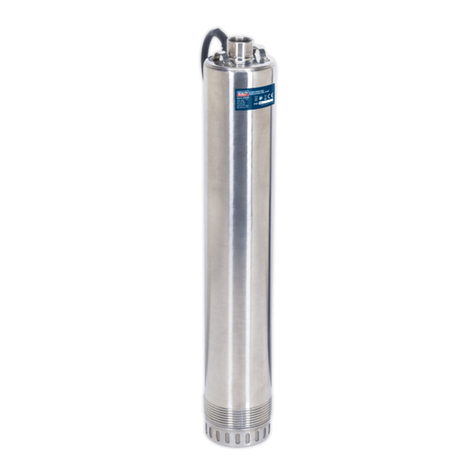
Sealey
Sealey WPW9355 instructions
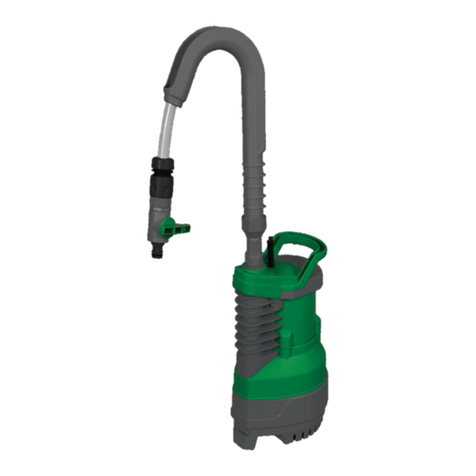
Ribimex
Ribimex PRPVF500AUTO User and maintenance manual

POMPE ROTOMEC
POMPE ROTOMEC TR Series Use and maintenance manual

Oase
Oase ProMax Garden Automatic 3500 operating instructions
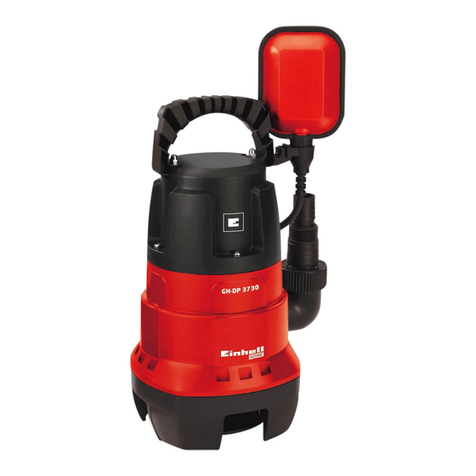
EINHELL
EINHELL GC-DP 3730 Original operating instructions
